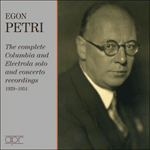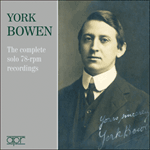
Welcome to Hyperion Records, a British classical label devoted to presenting high-quality recordings of music of all styles and from all periods from the twelfth century to the twenty-first.
Hyperion offers both CDs, and downloads in a number of formats. The site is also available in several languages.
Please use the dropdown buttons to set your preferred options, or use the checkbox to accept the defaults.

 PERFORMANCE
PERFORMANCE RECORDING
RECORDING


It is no wonder that the F sharp major sonata, Op 78, is totally different from the ‘Appassionata’. It is concise, unpretentious and to the point. And yet the opening four-bar introduction is as beautiful as anything he wrote. This is the only piece Beethoven composed in this unusual key—so unusual for him that he sometimes put the wrong number of sharps in the key signature. After this brief slow introduction, the tempo marking is Allegro ma non troppo, and it must not be hurried. Every note has to speak, especially the semiquavers. Even the rests are hugely expressive. The writing already foreshadows Beethoven’s late style, and is not as innocent as it looks.
The second and final movement is as brief as it is difficult to bring off. The opening theme contains a quote from Thomas Arne’s ‘Rule, Britannia’, on which Beethoven had already written a set of variations in 1803. It scampers about, with several piano passages at the top end of the keyboard. The two-note figures have to remain distinct, with a slight separation between them. Beethoven hadn’t lost his sense of humour.
The sonata is dedicated to Countess Therese von Brunswick (which is why it is known as the Sonata ‘à Thérèse’)—once thought to be a candidate for Beethoven’s ‘Immortal Beloved’. It was one of the composer’s favourite sonatas, and seems to have had some special significance for him.
from notes by Angela Hewitt © 2015
Il n’est pas étonnant que la sonate en fa dièse majeur, op.78, soit totalement différente de l’«Appassionata». Elle est concise, sans prétention et pertinente. Toutefois, l’introduction de quatre mesures est aussi magnifique que tout le reste de son œuvre. C’est la seule que Beethoven ait composée dans cette tonalité inhabituelle—tellement inhabituelle pour lui qu’il mit parfois un nombre de dièses erroné à la clef. Après cette courte introduction lente, le tempo indiqué est Allegro ma non troppo et il ne doit pas être précipité. Chaque note doit parler, surtout les doubles croches. Même les silences sont très expressifs. L’écriture annonce déjà le style tardif de Beethoven et n’est pas aussi innocent qu’il y paraît.
Le second et dernier mouvement est aussi court que difficile à réussir. Le thème initial contient une citation du «Rule, Britannia» de Thomas Arne, sur lequel Beethoven avait déjà écrit des variations en 1803. Il sort en gambadant, avec plusieurs passages piano dans l’aigu du clavier. Les figures de deux notes doivent rester distinctes, avec une légère séparation entre elles. Beethoven n’avait pas perdu son sens de l’humour.
Cette sonate est dédiée à la Comtesse Therese von Brunswick (raison pour laquelle on l’appelle la Sonate «à Thérèse»)—qu’on considéra à un moment donné comme l’une des candidates plausibles au rôle de «l’immortelle bien-aimée» de Beethoven. C’était l’une des sonates préférées du compositeur et elle semble avoir eu pour lui une importance particulière.
extrait des notes rédigées par Angela Hewitt © 2015
Français: Marie-Stella Pâris
Es ist kein Wunder, dass die Sonate Fis-Dur op. 78 sich völlig von der „Appassionata“ unterscheidet. Sie ist präzise, schlicht und sachlich gehalten. Und doch ist die viertaktige Einleitung zu Beginn eine seiner schönsten Passagen überhaupt. Es ist dies das einzige Werk, welches Beethoven in dieser ungewöhnlichen Tonart schrieb—sie war derart ungewohnt für ihn, dass er zuweilen die Vorzeichen falsch angab. Nach dieser kurzen, langsamen Einleitung lautet die Tempobezeichnung Allegro ma non troppo und es sollte nicht gehetzt werden. Jeder Ton muss sprechen, insbesondere die Sechzehntel. Selbst die Pausen sind ungeheuer ausdrucksvoll. Der Kompositionsstil nimmt bereits Beethovens Spätstil vorweg und ist nicht so unschuldig, wie er scheint.
Der zweite und letzte Satz ist sowohl kurz als auch knifflig zu spielen. Das Anfangsthema enthält ein Zitat aus „Rule, Britannia“ von Thomas Arne, worüber Beethoven bereits 1803 einen Variationenzyklus geschrieben hatte. Es flitzt herum und mehrere Piano-Passagen erklingen im oberen Register des Klaviers. Die Zweiton-Figuren müssen deutlich und voneinander jeweils leicht abgesetzt bleiben. Beethoven hatte seinen Sinn für Humor nicht verloren.
Die Sonate ist der Gräfin Therese von Brunsvik gewidmet (weshalb sie auch als Sonate „à Thérèse“ bekannt ist), die einst als Kandidatin der „Unsterblichen Geliebten“ Beethovens gehandelt wurde. Das Werk war ein Lieblingsstück des Komponisten und scheint für ihn von besonderer Bedeutung gewesen zu sein.
aus dem Begleittext von Angela Hewitt © 2015
Deutsch: Viola Scheffel
 Beethoven: Beethoven Unbound Beethoven: Beethoven UnboundA comprehensive new cycle of the Beethoven sonatas recorded live at London's Wigmore Hall during the pianist's epic fourth rendition of these masterpieces .» More |
 Egon Petri - The complete Columbia and Electrola solo and concerto recordings Egon Petri - The complete Columbia and Electrola solo and concerto recordingsEgon Petri (1881-1962) studied with Busoni and was perhaps his greatest disciple. In his fusion of intellect with an astonishing virtuoso technique he echoed his master and gives us today the clearest idea of Busoni’s own legendary pianism.» More |
 York Bowen - The complete solo 78-rpm recordings York Bowen - The complete solo 78-rpm recordings‘Well filled set and plenty to arrest the imagination’ (MusicWeb International)» More |

